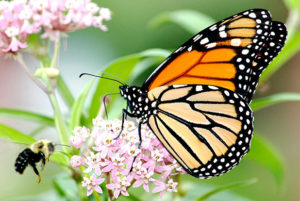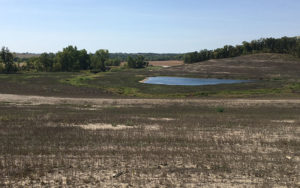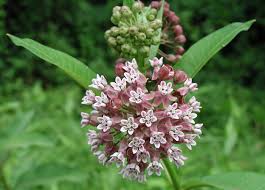Monarch butterflies are the staple of a beautiful creature. Spending an hour at the Logan Abandoned Mine Land (AML) south of Oskaloosa in Bussey, you are able to witness the pure grace of a Monarch Butterfly.
Monarch Butterflies — like many other pollinators — are crucial to ecosystems by the act of pollination. Monarch Butterflies are unique in the fact that they are semi-dormant butterflies. The east population of monarchs move south as the weather gets colder to Mexico City where they congregate in a forest, according to ISU Research Team Agronomist Seth Appelgate.
The Research Team from Iowa State University along with members of the Iowa Monarch Conservation Consortium, National Fish and Wildlife Foundaiton, Iowa Department of Agriculture and Land Stewardship, and Pathfinders RC&D were in attendance at a field day at AML for the public. The Iowa Learning Farms (ILF) had organized the event in its entirety; ILF was established in 2004 to build a partnership with various conservation organizations to create a Culture of Conservation. The Iowa Department of Natural Resources also had members in attendance. Members of the ILF “work together to identify and implement the best management practices that improve water quality and soil health.”
While the monarchs congregate in Mexico City, researchers are able to estimate the population of the nearly endangered species by measuring hectors. (1 hector = 2.5 acres) Appelgate says that 6 hectors are needed in Mexico for sustainability of the monarch. Sustainability and population growth is imperative due to the fact that the monarch butterfly population has been on a steady decline in the last 20 years of 80{99cd714f394079a7f0ed2eb1518dd31342ff3ceb5b6c267c3ad8acd5b5a7d66b}.

Iowa plays an important role in the breeding ground for Monarch butterflies and other pollinators. The AML in Bussey is now a wonderful breeding ground location for monarch butterflies. The mine land had been reclaimed as a way to return land back to its pre-mining condition, the project was completed in the fall of 2016.
The location is Bussey is one of more than 300 abandoned mines in the state of Iowa spanning over 13,000 acres, and a majority of them are located in southeastern Iowa. The project was necessary due to the safety and public health hazards, plus improving. This reclaimed land provides opportunities to establish monarch habitats similar to roadsides, ditches and homes or gardens.

Anna Bruin with Pathfinders RC&D – who partners with various environmental organizations in Iowa – says Pathfinders has helped to fund a grant to aid in monarch conservation.
Bruin’s advice for residents in Mahaska County “whether you have a large swath of land (20-40 acres) or a small part of land (1 to 5 acres) or even living in town, you can plant pollinator habitat.”
One of the reasons why the population of monarchs is decreasing so drastically is due to the fact that the insect is quite particular about where and which plants they lay their eggs on and feed off of.
Monarchs are milkweed obligates because females will only lay eggs on milkweed, and larvae will only feed on milkweed. By eating milkweed, caterpillars collect toxins from the plant called cardiac glycosides, which are isolated in the exoskeleton of the caterpillar and the wings of the adult. When ingested by vertebrate predators it will cause them to vomit or have a mild heart arrhythmia that promotes learned avoidance. Consuming milkweed as a larvae will allow the adult to create its own line of self-defense.

The issue with the natural grown milkweed plant it is normally mowed over or destroyed because the average person sees it as a ditch weed. This plant, however, is vital for the regeneration of monarch butterflies. There are roughly 100 species of milkweed in the United States and out of those hundred, 17 of those are native to Iowa.
Milkweed species are normally found in grassland, damp soils or wetlands, but a few species occur in deciduous forest or in deserts particularly swamp milkweed and whorled milkweed, may be preferred by monarchs. Adult monarchs feed off of various wildflowers or flowering plants. Butterflies can be seen roaming wild prairie grass fields that have wildflowers.
Planting sap-producing plants, no matter where, is important to the livelihood of the monarch conservation. “The more patches Mahaska County has,” said Bruin, “the better continuity the monarchs will have during migration.”
The best time to organize and plant a monarch habitat is in the late fall, ideally November or December. If monarch habitat is planted in the spring it needs to be planted as early as possible. Soil temperatures for fall planting should be 40 degrees or colder to prevent fall germination. Grasses, sedges, and large-seeded forbs should be planted at depths of 1/4-inch to 1/8-inch, no deeper.
Residents of Iowa can enjoy the beauty of monarchs normally from the months of May to September.
Information provided by the ISU Research Team and affiliates: Monarch Research – ISU



